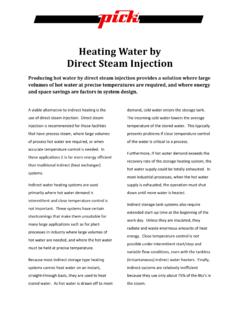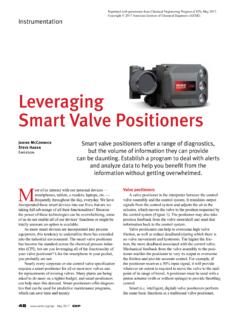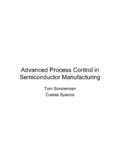Transcription of Producing Hot Water by Direct Steam Injection
1 Reprinted with permission from CEP (Chemical Engineering Progress), May 2010. Copyright 2010 American Institute of Chemical Engineers (AIChE). Back to Basics Producing Hot Water by Direct Steam Injection Philip Sutter Inline Direct Steam Injection is more energy ef cient Pick Heaters than indirectly heating Water in a tank. Use this overview of DSI equipment to select the appropriate system for your application. D. irect Steam Injection (DSI) is a viable alternative Btu/lb. As Steam condenses in a heat exchanger, only the to indirect heating for many applications that use latent heat (about 880 Btu) is released to heat the Water . The process Steam , require large volumes of hot Water , or condensate, which still contains at least 309 Btu, is at 338 F. need accurate temperature control. As the name implies, DSI This condensate is either returned to the boiler or discharged systems inject Steam directly into cold Water , unlike indirect from the system (and its heat content wasted).
2 Heating, which transfers heat by conduction through a metal As the condensate returns to the boiler, energy may be wall or tube. lost through faulty Steam traps and ancillary equipment. With its high energy efficiency, compact footprint, accu- Leaking Steam traps, which are a major cause of energy rate temperature control, and ability to provide a continuous waste, incur high maintenance costs. Additional heat is lost supply of hot Water , DSI overcomes some of the shortcom- by radiation from condensate return lines. At the receiver ings inherent in the indirect approach (see sidebar). This tank, more energy is lost when the condensate flashes as it article looks at these advantages and compares different is reduced to atmospheric pressure. Overall efficiency falls, types of DSI systems. too, as mineral deposits accumulate on the wetted side of the metal conductor and create an insulating barrier. DSI advantages With Direct Steam Injection , 100% of the Steam con- Energy efficiency.
3 Using virtually all of the energy in the denses as it heats the Water . There is no need for condensate Steam to heat the Water , DSI systems are up to 28% more return lines with their attendant energy losses and Steam trap energy efficient than indirect systems. Steam coils or heat maintenance problems. exchangers are, at best, about 75% efficient, because only Compactness. Even the most sophisticated DSI Water about three-quarters of the energy in the Steam is actually heating systems are so compact that they can be suspended used to heat the Water . from a wall or ceiling or mounted on a compact skid on the For example, saturated Steam at 100 psig contains 1,189 floor. This type of system is preferred where space does not allow for a storage tank. When a large storage tank must be Storage Tank Steam replaced, a Steam Injection system is easier to install in an existing building than a new large storage tank. Temperature control.
4 The more-sophisticated DSI sys- Steam Valve tems provide very close temperature control at both constant and variable flowrates and in applications that involve fre- quent stopping and starting. This control is possible because heat transfers immediately from the Steam to the liquid when Steam heating starts. When demand and Steam flow stop, heating ceases at once, unlike in a heat exchanger, which continues Spargers to release residual energy. S Figure 1. A Steam sparger has a perforated pipe through which Steam is Continuous hot Water supply. Direct Steam Injection bubbled directly into the Water in a vented storage heats the Water instantly on a continuous straight-through 48 May 2010 CEP. basis as it is used. A DSI system that is properly sized for Steam Cold Water Inlet Inlet the available Steam supply, cold Water supply, and hot Water demand can continuously deliver hot Water as required. The user does not run out of hot Water , and does not need to store large quantities of hot Water .
5 Types of Steam Injection systems Several methods can be used to inject Steam into cold Water . These methods differ primarily in their ability to adjust to variations in Steam pressure, incoming Water pres- sure, and hot Water demand. The most-sophisticated Injection systems adjust automatically for these variations; others have Hot Water more limited capabilities, but are adequate for some situa- tions. The following discussion explains how these systems S Figure 2. Mixing tees blend Steam with cold Water . They may have work and where they can be used effectively (Table 1). manual (shown), semi-automatic, or automatic temperature controls. Sparger. The simplest DSI system is the Steam sparger, which is a perforated pipe or other fixture through which rises to the surface and flashes to the atmosphere, wasting Steam is bubbled directly into the Water in a vented storage energy. Sparging is usually less than 50% energy efficient.
6 Tank (Figure 1). Spargers are often installed in storage tanks Mixing tees. As the name implies, a mixing tee (Figure and boiler feedwater tanks. They are also commonly used to 2) is a T-shaped device that blends Steam with cold Water . heat cryogenic fluids. Mixing tees may have manual, semi-automatic, or automatic Sparging systems are simple and relatively inexpensive temperature control. With a manual mixing tee, the opera- to install, but their limitations can outweigh their benefits in tor first turns on the cold Water , then opens the Steam valve many applications. It is difficult for spargers to achieve and to admit enough Steam to heat the cold Water ; this type of hold a set Water temperature, and heating large volumes of system can achieve only approximate temperature control. Water can take a long time. Because there is no way to bal- Semi-automatic mixing tees require manual adjustment of ance the pressure of the Steam in excess of the surrounding Steam and Water , but they have an automatic Steam shutoff Water pressure, sparging often causes severe Water hammer that is activated if the Water supply is interrupted.
7 With auto- and vibration that damages storage tanks. Finally, sparg- ing is the least efficient method of heating Water because The Limitations of Indirect Heating as Steam is injected into the bottom of a tank, some of it Just like Direct Steam Injection systems, indirect heating Table 1. Many common CPI applications can be handled by has advantages and disadvantages. more than one DSI method. Indirect storage-tank heating systems require extended start-up time at the beginning of the work Application Sparger Mixing Venturi Dual day. Most are not insulated, so they radiate and waste Tee Modulating enormous amounts of energy. Close temperature control General Plant Cleanup is not possible under the intermittent start/stop and variable-flow conditions that are typical of indirect heat- Tank Car Washing ing, even with tankless (instantaneous) Water heaters. Since most indirect storage-tank heating systems Tank Car Heating cannot heat Water instantaneously, they are used to heat stored Water .
8 As hot Water is drawn off to meet demand, Brackish Water Heating cold Water enters the storage tank. The incoming cold Filter Washing Water lowers the average temperature of the stored Water , thus complicating efforts to maintain and control Line Tracing temperature. When hot Water demand exceeds the maximum Cleaning and Sanitizing capability of the storage-tank heating system to generate (Clean in Place) an adequate amount of heated Water , the supply of hot Adding Water to a Batch Process Water could be depleted. In most industrial processes, when the hot Water supply is used up, the operation must Heating Jacketed Reactors, be shut down until more Water is heated. Indirect systems are relatively inefficient because they Blenders, and use only about 75% of the available energy in the Steam . Other Vessels CEP May 2010 49. Back to Basics matic mixing tees, the temperature setpoint is programmed prevents workers from misadjusting individual wash- into a controller and then the Steam and Water supplies are station mixing tees.
9 Turned on. Venturi Injection systems. In the venturi (or eductor). Manual and semi-automatic mixing tees cannot adjust method, Steam is drawn into the cold Water through a ven- for variations in Steam pressure, Water pressure, or hot Water turi or constriction in the Water line (Figure 3). By passing demand. Therefore, they are not recommended for use in through the venturi, Steam enters the Water at a high (sonic). plant sanitizing situations that require Water heated to 180 F. velocity. This creates a pressure differential and generates They are, however, adequate for general plant washdown, turbulence that promotes rapid mixing of the Steam and and are often used in wash stations. Unless correctly oper- cold Water . ated and properly maintained, manual and semi-automatic Venturi systems may have either a fixed orifice or a systems can be hazardous because live Steam may be ejected variable orifice. As their name implies, fixed-orifice venturi if the cold Water supply is abruptly stopped.
10 Systems cannot be adjusted for variations in Steam pressure, When specifying DSI for multiple wash stations, it may Water pressure, or hot Water demand. They are satisfactory be worthwhile to compare the cost of several individual only in applications where these conditions remain constant. mixing tees with the cost of a central variable-flow Steam In a variable-orifice venturi system, the Steam flow or Injection system, especially if the temperature requirement Water flow can be adjusted to deliver Water at different tem- is the same at all the wash stations. In general, if three or peratures. The adjustment may be manual or pneumatically more wash stations are called for, the installed cost of a regulated. Where Steam pressure, incoming Water pressure, central system may be lower. In addition, a central system and hot Water demand remain fairly constant, variable- Steam Orifice Adjustment Heated Pneumatic Liquid Controller Hot Water Injection Tube Helical Cold Water Flights S Figure 3.










